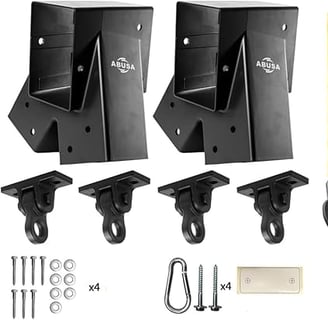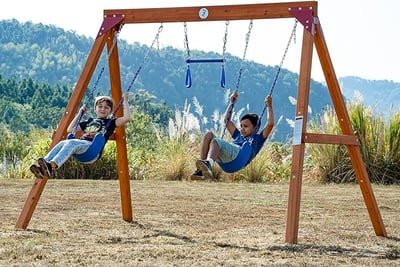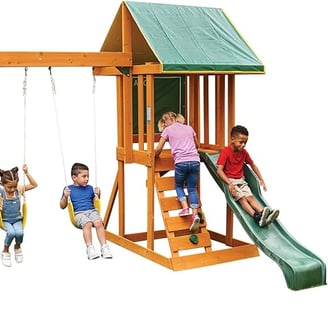DIY Wooden Swing Set: A Fun Backyard Project for Families
8 min read


Introduction to DIY Wooden Swing Sets
Building a DIY wooden swing set is not only a captivating project but also an invaluable addition to any family’s outdoor space. The concept revolves around creating a custom, sturdy structure that can facilitate countless hours of play and adventure for children. One of the primary advantages of constructing a swing set is the opportunity it offers for outdoor play. With the modern tendency for children to engage more with screens, a well-designed swing set encourages them to step outside and enjoy the benefits of physical activity and fresh air. Not only does this contribute to better health and well-being, but it also fosters creativity, as children can engage in imaginative play while swinging, climbing, and exploring.
Moreover, a DIY wooden swing set enhances family bonding. Engaging in the building process allows family members, including kids, to collaborate, learn new skills, and share responsibilities. This not only strengthens relationships but also teaches children about the value of teamwork and perseverance. As families work together to measure, cut, and assemble the swing set, they create lasting memories that extend beyond the construction phase, enjoying the completed product together in their backyard for years to come.
Choosing to build a DIY wooden swing set can also be a rewarding experience for both adults and children alike. It becomes an expression of creativity, tailored to specific needs and preferences, whether it is incorporating additional features like slides, climbing walls, or custom colors. Additionally, with numerous resources available online, families can easily access plans and ideas that simplify the construction process, making it approachable for individuals with varying levels of expertise. Ultimately, the endeavor is not only about creating a playground but cultivating a shared sense of accomplishment and joy within the family unit.
Choosing the Right Location for Your Swing Set
When embarking on the project of building a DIY wooden swing set, selecting an appropriate location is essential for ensuring both safety and enjoyment. Several key factors come into play when determining the best site for your swing set. First and foremost, safety should be the top priority. It is vital to choose an area that is free from potential hazards such as overhanging branches, power lines, and any sharp objects that may pose a risk to children while they play.
Another important consideration is the amount of space available. A swing set requires sufficient area for both the structure itself and the surrounding clearance. Ideally, there should be a minimum of six feet of space on all sides of the swing set to allow for safe usage. This not only protects children from injuries but also gives them plenty of room to swing and play freely. Assess the dimensions of your swing set and ensure that it fits comfortably within the designated space without feeling cramped.
Accessibility is another key element in selecting the location. The swing set should be close enough to your home or supervising area so that adults can easily monitor the children's activities. This ensures that parents can maintain a watchful eye while participating in other tasks nearby. Moreover, it is advisable to find a level piece of ground for the swing set. Uneven terrain can lead to instability, increasing the risk of tipping or accidents. Before installation, measure the area appropriately, using stakes and strings to outline the space. Verify that the ground is flat, and if necessary, consider leveling it with soil or other materials before proceeding with construction.
Materials and Tools Needed for Construction
Building a wooden swing set requires careful selection of materials and tools, ensuring both safety and durability in the final product. To begin the construction process, you will need high-quality wood, typically pressure-treated lumber or cedar, both of which offer excellent resistance to weather elements and decay. The dimensions should include 4x4 posts for the frame, 2x4s for cross-bracing, and 2x6s for the seat swings. Additionally, consider using plywood for the platform if you plan to add a playhouse element.
In terms of hardware, you will need a variety of items to ensure stability and safety. Heavy-duty swing hangers, bolts, screws, and safety caps are essential for securing the structure and attaching swings. Galvanized hardware is recommended to prevent rusting, enhancing the swing set's longevity. Moreover, don’t forget to source safety equipment such as rubber mats or wood chips to cushion the area beneath the swing set, mitigating the risk of injury during play.
All required materials can be sourced from local lumberyards and home improvement stores, which often carry a selection of quality woods and hardware. National suppliers such as Home Depot or Lowe's provide extensive inventories online, allowing you to compare prices and find the best deals. Additionally, niche retailers specializing in outdoor play equipment may offer complete swing set kits, streamlining the acquisition process and ensuring that you have all the necessary components to finish your project successfully.
Ultimately, investing time in selecting the right materials and tools not only elevates the quality of your wooden swing set but also enhances the safety and enjoyment for your family. Prioritize sourcing from reputable suppliers to guarantee the best outcomes for your DIY adventure.
Step-by-Step Guide to Building Your Swing Set
Constructing a DIY wooden swing set can be an enjoyable and rewarding experience for families. To begin, gather all necessary materials and tools such as pressure-treated lumber, swings, wood screws, a drill, and a saw. Adequate planning is essential; sketch a design with detailed dimensions that includes the overall height, width, and swing support based on your backyard layout.
Once the design is settled, mark the location for the swing set. Choose a flat area away from potential obstacles such as trees, fences, or uneven ground. Dig holes for the support posts, ensuring they are deep enough to provide stability. A depth of at least two feet is typically recommended for safety, particularly for larger structures. It's crucial to check local regulations to ensure compliance with any building codes.
Next, assemble the support frame. Using 4x4 lumber for the vertical posts and 2x6 lumber for the horizontal beams will provide solid support. Secure the posts vertically in the dug holes and fill them with concrete mix for increased stability. After the concrete has set, attach the horizontal beams across the top of the posts, ensuring they are level and positioned correctly.
Once the frame is complete, install the swings. Choose the appropriate height for the swing seats and secure the swing hangers to the top beam using heavy-duty hardware. Ensure that each swing is positioned with adequate space between them to prevent interference during use. Additionally, consider adding a safety seatbelt for younger children.
Common mistakes include underestimating the swings’ height and failing to reinforce the frame adequately. It is essential to focus on safety throughout the process. Regularly inspect the swing set after completion for any loose screws or damage. With proper attention to detail and careful planning, you can construct a sturdy and enjoyable swing set that will provide years of fun for your family.
Paint and Finishing Touches for Durability
When it comes to constructing a DIY wooden swing set, painting and applying finishes play a vital role in ensuring the longevity and durability of the structure. Exposure to various weather conditions, such as rain, sunshine, and humidity, can lead to deterioration of the wood over time. Therefore, selecting the right type of paint and finishes is crucial to protect your investment.
There are several types of finishes available, including exterior paint, stains, and sealants. Exterior paint provides a robust layer of protection against moisture and UV rays while allowing for vibrant colors that can enhance the aesthetic appeal of the swing set. One recommended brand for exterior paint is Sherwin-Williams, known for its durability and resistance to fading. Alternatively, stains like Behr and Minwax offer a more natural look, allowing the grain of the wood to show through while still protecting it from moisture and mildew.
For optimal durability, a combination of stain and sealant may be the best approach. The stain will add color and protect the wood, while a clear sealant will provide an additional barrier against the elements. It is essential to choose products specifically formulated for outdoor use, as these are designed to withstand harsh conditions better than indoor finishes.
Applying the finish involves careful surface preparation, which includes sanding the wood to ensure smoothness and cleaning it to remove dust and debris. It is recommended to apply at least two coats of your chosen finish, allowing adequate drying time between applications. Using a high-quality brush or roller promotes even application and enhances the overall look of the swing set. Overall, proper painting and finishing will not only protect the wood but also contribute to a visually appealing addition to your backyard.
Safety Precautions and Maintenance Tips
Constructing a DIY wooden swing set can be a rewarding and enjoyable project for families. However, safety must be the foremost priority both during construction and while the swing set is in use. First and foremost, select a suitable location for the swing set that is flat and clear of obstacles such as trees, fences, or hard surfaces. It is essential to ensure that the area is spacious enough to allow for safe swinging movements without the risk of collision.
When building the swing set, utilize high-quality materials that are designed to withstand outdoor conditions. Ensure that all wooden components are sanded down to eliminate sharp edges that may pose a risk to children. The swing set should be anchored securely to the ground, which helps prevent tipping or shifting during use. Additionally, all bolts, screws, and fasteners should be tightly secured, with regular checks performed to ensure they remain intact over time.
Regular maintenance is crucial to preserving the safety and functionality of the swing set. Schedule periodic inspections to check for signs of wear and tear, particularly on the swings and the structural components. Wooden elements should be inspected for splinters, cracks, or signs of rot; addressing these issues promptly can prevent accidents. Swings, chains, and other moving parts should be checked for wear, and any damaged components should be replaced immediately.
A great practice is to clean the swing set on a regular basis. Remove any debris, dirt, or organic matter that may accumulate on the structure to prevent deterioration. Every few years, consider applying a weatherproof sealant to the wood, enhancing its durability against the elements. These proactive measures ensure not only a safer environment for children to play but also prolong the life of your DIY wooden swing set, allowing families to enjoy it for years to come.
Encouraging Outdoor Play and Family Fun
Having a swing set in the backyard offers numerous benefits that significantly contribute to a family’s overall well-being. One of the primary advantages is the encouragement of physical activity. Children are naturally inclined to be active, and a swing set provides an engaging way to promote exercise. Swinging can enhance cardiovascular fitness, build strength, and improve coordination. Regular outdoor play not only keeps children physically healthy but also helps reduce screen time, fostering a more active lifestyle.
In addition to physical benefits, a swing set serves as a platform for imaginative play. Children often craft intricate games and scenarios that stimulate creativity, allowing them to explore various roles and environments. This kind of imaginative engagement is crucial for cognitive development, as it encourages problem-solving and enhances social skills through collaborative play. The versatile nature of a swing set—where swings can transform into a spaceship or a fort—offers countless opportunities for families to interact in a dynamic setting.
A swing set also significantly promotes family bonding. It creates a dedicated space for families to spend quality time together, whether through playful banter while pushing a swing or engaging in games that involve everyone. Parents can foster meaningful connections with their children during these outdoor activities, making lasting memories. To enhance the play experience, families might consider incorporating additional features around the swing set, such as a sandbox, climbing wall, or picnic area, further promoting family fun and engagement.
Ultimately, the presence of a swing set elevates backyard experiences by encouraging physical activity, sparking imaginative exploration, and providing a nurturing environment where families can connect, making it a valuable addition to any home.











